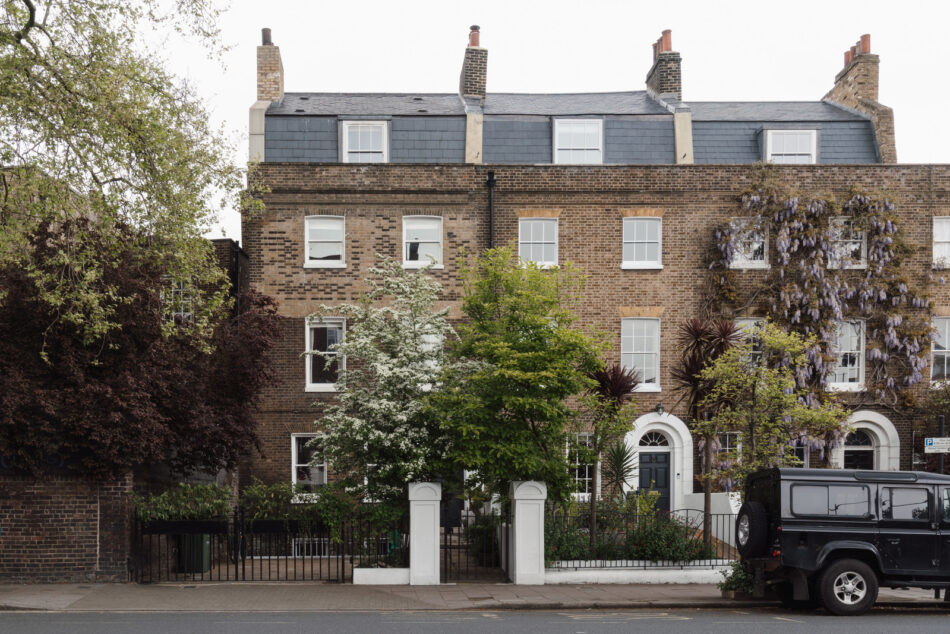
Dating to c.1800, this exquisite, five-bedroom Grade II-listed Georgian townhouse cuts a striking profile on Lambeth Road, within the Lambeth Palace Conservation Area. Across its five storeys are bright and considered spaces, all impressively quiet despite their proximity to the South Bank, Waterloo and Southwark. Inside is something of a palimpsest, with its original early 19th-century characteristics placed next to lovingly retained mid-century features and its now more contemporary interventions, overseen by architect Grace Fletcher in collaboration with Archer + Braun. At the rear is an astonishingly considered garden, filled with rare plantings, a stately tree of heaven (once a part of neighbouring Lambeth Palace’s grounds) and a whimsical stepping stone pond.
Setting the Scene
The house is one of a handful of tall Georgian houses along Lambeth Road, all built around the turn of the 19th century. In the mid-20th century, it was lived in by the grandson of the esteemed British architect Edwin Lutyens, who, as an MP, chose the house for its proximity to the Houses of Parliament.
Today, the house is a wondrously thought-out space, with adaptations made to its historic bones to allow for meaningful modern living. At its rear is a beautifully crafted, Dezeen Award-listed extension (also featured in the RIBA Journal) that adjoins an exposed original wall. Throughout, materials have been chosen to sensitively mesh with its Georgian frame, including reclaimed Ballachulish slate and silver travertine tiling. While old and new sit proudly together across the home, this harmonious contrast is perhaps most palpable in the staircase, where a bespoke green geometric wallpaper by Hamilton Weston was designed to mimic the earlier 1960s version still visible above one of the house’s original exposed beams. For more information, see the History section.
The Grand Tour
Set back behind a long, neat garden planted with hawthorn and paulownia, the house’s profile hints towards the generous proportions within. Its Georgian façade is immaculate, with richly toned brickwork, tall stucco-dressed sash windows and ornate segmental pedimented piers. Automated electric gates run along the front boundary and open to an off-street parking space. Yorkstone flags with engravings pave up to the refined front door, set within a rusticated stucco surround.
Entry is to a generous hallway, where walls to either side are lined with antique maps of London, one of which is believed to be around 100 years old. There is plenty of space to kick off shoes and hang up coats here too, all while surveying the historic streets of the city. This area is grounded by the original pine floorboards, more recently sanded and stained, that run throughout the house.
To the left is the double reception room, a generous space with ceilings traced by box cornicing. The house’s Georgian proportions are here illuminated by original twin sash windows at the front (enhanced with sound-reducing thickened glass) and by two further windows opposite, along the rear wall. Dotted across the room are shell-shaped carvings, adorning the bookcases that run across the room as well as the large central fireplace surround. The front and back have been arranged in an open plan that makes for hassle-free hosting, although its versatility would allow for creative configurations of the space.
Down a short flight of stairs from the entry hall is the wonderful open-plan dining and kitchen room, the contemporary heart of the home with views of the luscious garden beyond. Designed by Grace Fletcher in collaboration with Archer + Braun, its sculptural form is well-lit by roof lights above. For the green-thumbed, a rainwater reclamation system has been ingeniously fitted, perfect for nourishing a favourite ficus or hardy monstera. Materials here have been chosen for their hardiness and perennial appeal: walls are finished with clay plaster, Italian travertine slabs run underfoot and are warmed by underfloor heating, accoya windows and doors introduce honeyed tones into the scheme, and sapele moving furniture brings flexibility.
An original brick wall divides the extension from the kitchen behind, with an open fireplace and doorway that provide an easy flow. Cabinetry snakes around the room and is composed of beautiful birch ply with Italian granite countertops; kitchen appliances – including a Rangemaster and Samsung fridge have been subtly integrated. Beyond is an additional sitting room, used by the current owners as a fantastic study space with 19th-century quarry tiles underfoot.
A staircase in the core of the house is surrounded by a geometric green and white geometric wallpaper by Hamilton Weston, designed to echo an earlier 1960s version that remains on the top floor’s landing. On the first storey is the main bedroom, where walls are finished in Felt by Paint and Paper Library, and two exceptionally tall sash windows draw in copious amounts of light. The bed is arranged in front of the chimney breast, with cupboards fitted into the alcoves at either side. Opposite, contemporary slatted wardrobes offer ample storage space. Despite its modern feel, the room abounds with period features: cornicing and a dado rail adorn the walls, as do mounted midcentury frames used historically to surround paintings.
Across from here is the house’s largest bathroom, complete with a step-in bath. Here, tiles are handmade Milagros tiles from Mexico. Across the other bathrooms, are handcrafted Zellige – exceptionally lovely and in rich shades of blue – from Emery et Cie.
Over the top two storeys are four further bedrooms and a second generous bathroom with a clawfoot bathtub. Two bedrooms claim the eaves space, one with an ingenious mezzanine structure for storage, the other with a sumptuously refined en suite bathroom and an electronically operated skylight.
Outdoor Space
A creatively planted garden at the rear makes use of its long plot by dividing it up into distinct zones. With its enchanted, woodlandish feel, the spot is a haven amid the city, planted with an almost entirely evergreen offering of plantings. Supremely tranquil, it backs onto the arboreal Archbishop’s Park, once a part of Lambeth Palace’s grounds.
The garden has sunny and shaded spots in equal measure, with the canopies of several mature trees, including a Judas tree and a tree of heaven, making for a wonderful spot to get lost in a book beneath. The current owner has lovingly cultivated several specialist plants, including a tsumugi-shibori variation of fatsia japonica and a host of ferns, that sit adjacent to camelia japonicas planted in the mid-20th century.
A small terrace adjoins the extension at the rear and has an integrated bench to one side. Behind is a pond with stepping stones that add to the escapist allure of the garden.
Out and About
Exceptionally located in the heart of Lambeth, the house is within walking distance of some of the city’s most-loved haunts. To the west, three minutes away on foot, is the Garden Museum with its award-winning Garden Café. The museum is extensively involved in plans for the new adjoining ‘Lambeth Green’, a community space to be co-created by landscape designer Dan Pearson and architect Mary Duggan.
The South Bank, with the Southbank Centre, BFI and The National Theatre, as well as its range of restaurants, bars and cafés, is to the north. Even closer to home is the Lower Marsh Street, where a weekday market has a global offering of delicious food. Greensmiths, an independent grocer and butcher, is located here, with Little Bread Pedlar nearby too. Along The Cut in Southwark are a further variety of eateries, including an outpost of Gail’s (with a second branch nearby in Lambeth) as well as The Anchor and Hope, a wonderful pub serving excellent drinks and even better food. The Old Vic and The Young Vic theatres can also be found here, with their varied theatrical programmes.
There are a variety of schooling options in the local area, both private and state-run. King’s College Maths School and Notre Dame Girls’ School are both close and rated “Outstanding” by Ofsted, with more, including Westminster School, just across the river.
Transport connections are brilliant: Lambeth North (Bakerloo) is an 8-minute walk away, while Westminster can be reached in around 15 minutes on foot. Waterloo and Southwark stations are also nearby, for Jubilee Line and/or National Rail Connections. The area is also well-served by bus links, and its central location makes for easy walking distance into central London.
Council Tax Band: F
History
This house on Lambeth Road stands in a row of twin terraces built in 1778 by carpenter William Head and plumber Joseph Buckmaster. Each house has three storeys, a sunken basement, and two sash windows under flat brick arches.
The road has an eclectic history. In one of the houses, Singleton’s Eye Ointment was produced, the brainchild of Lambeth doctor Thomas Johnson. It was marketed in ceramic pots with blue lettering reading, ‘Singleton’s Golden Eye Ointment’, claiming to be a cure for all eye disorders, and was even thought to be able to restore eyelashes.
For a year, the street was home to author and dramatist W.T. Moncrieff, whose plays at Drury Lane necessitated the use of real horses, and a real waterfall. His later play, ‘Tom and Jerry’, was the first play to achieve a 100 performance run.
The school buildings at the end of the row were taken over by the Marine Society and Sea Cadets in the 20th century, and are still used by the MSSC to this day.
Interested? Let’s talk
Related Listings
- A Private View: A slate-clad structure completes this personal family portrait in LambethHomes / Interiors
- A Room of One's Own: Mary Graham's nostalgic country house bedroomA room of ones own / Homes / Interiors
- A Room of One's Own: Fee Greening's bewitching shepherd's hut in rural DorsetA room of ones own / Homes / Interiors
- A Private View: A Roman relic rises from the ruins in CaerwentHomes
- Cottage Craving: five storybook dwellings that capture the quintessence of cosyHomes

